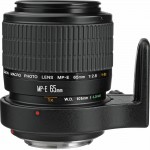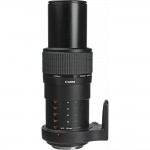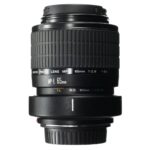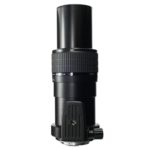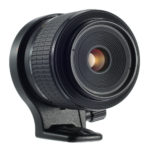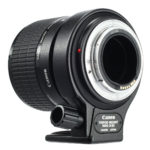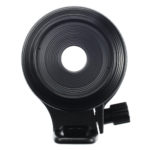Canon MP-E 65mm F/2.8 1-5x Macro Photo
Macro lens • Film era
- Announced:
- · September 1999
- Production status:
- ● In production
- Country of design:
- · Japan
- Original name:
- · CANON MACRO PHOTO LENS MP-E 65mm 1:2.8 1-5x
- Class:
- · Fast full-frame macro lens
- · Professional model (Top class)
- System:
- · Canon EOS (1987)
Abbreviations
| E | The lens incorporates an electromagnetic diaphragm mechanism. |
| MACRO | Macro lens. Designed specially for shooting close-ups of small subjects. Learn more |
Specification
| Optical design: | |
| 35mm full frame | |
| 65mm | |
| F/2.8 | |
| 10 elements in 8 groups | |
| 1 UD | |
| Floating element system | |
| Canon EF [44mm] | |
| 36.8° (35mm full frame) | |
| On Canon EOS APS-C [1.59x] cameras: | |
35mm equivalent focal length: | 103.4mm (in terms of field of view) |
35mm equivalent speed: | F/4.5 (in terms of depth of field) |
Diagonal angle of view: | 23.6° |
| Diaphragm mechanism: | |
Diaphragm type: | Automatic |
Aperture control: | None; the aperture is controlled from the camera |
| 6 (six) | |
| Focusing: | |
| 0.24m | |
| <No data> | |
Focusing modes: | Manual focus only |
Manual focus control: | Focusing ring |
| Physical characteristics: | |
| 710g | |
| ⌀81×98mm | |
| Accessories: | |
| Screw-type 58mm | |
| Screw-type dome-shaped | |
| Not compatible |
Source of data
- Manufacturer's technical data.
Manufacturer description #1
This macrophoto lens allows expanded photography from life-size to 5x magnification. A floating system using three lens groups has been adopted to deliver high variable magnification in the macro region. It effectively corrects the aberration fluctuation which accompanies changes in magnification. With a UD lens element as the second element, secondary spectrum, a problem during high magnification, is minimised, guaranteeing outstanding imaging performance. The lens is equipped with an EMD (electromagnetic diaphragm) to deliver AE photography. Subtle adjustments to magnification are possible using the wide ring. A light-blocking line is incorporated into the front of the lens to reduce inclusion when very close to the subject. It is possible to use the Macro Ring Lite MR-14EX and the Macro Twin Lite MT- 24EX. The lens comes with a removable tripod mount which allows smooth switching between vertical and horizontal photography and offers solid support.
Manufacturer description #2
A unique manual-focus lens designed exclusively for macro shooting, between life-size (1x) and 5x life-size – at its maximum magnification, you can fill a 35mm frame with a grain of rice. Compatible with the Macro Ring Lites and new Macro Twin Lite, it eliminates the need for awkward bellows accessories for many macro shooters. A floating system preserves optical quality at different focusing distances, and features a UD-glass element.
From the Popular Photography magazine (July 2000):
Curious how the world looks at five times lifesize?
Canon's MP-E 65mm f/2.8 super macro is a great way to find out!
We've all seen scads of so-called macro lenses that get you down to 1:4 or 1:2. True macro lenses start at 1:1, however, and they're relatively few and far between. Now, Canon has dramatically expanded the "macro lens" envelope with its unique MP-E 65mm f/2.8 1X-5X Macro lens, an optic that delivers the greatest magnification this side of a microscope.
On the surface, there's little to suggest how unusual the 65mm f/2.8 Macro is. It has an attractive black, crinkle and satin finish barrel made of aluminum alloy, with a large 2 1/8-inch zoom ring, of which 1 1/4 inches is clad in a ribbed, rubber-like material.
Well-damped and smooth, the focusing doesn't require undue effort, but is stiff enough to assure that it stays where you set it with no creep. Barrel markings show the five magnification levels, 1X through 5X, in large, yellow silk-screened numerals. White and green numbers indicate working distances ("W.D.") in millimeters and inches, respectively. Working distances range from 4 inches at 1:1 to a very tight 1.6 inches at 5:1. (No, the lens cannot be used in a regular focusing range to infinity.) A supplied, 5-ounce aluminum tripod collar slides easily on and off the lens barrel, and balances a tripod-mounted rig nicely throughout the unusually wide extension range. The lens's outer ring is threaded to accept 58mm filters, and is sized to accommodate Canon's Macro ringlights, either the ML-3 or MR-14.
What makes the MP-E 65mm special is that it continuously focuses through the image magnifications from 1X to 5X with a fixed focusing distance for each magnification level. The focusing helical is unusually long, extending the lens almost a full inch as you go from 1:1 to 2:1, for example. In its 1:1 contracted position, the 1 lb 10 oz MP-E 65mm is 4 inches long; at 5:1, it more than doubles in length to 9 inches. The helical is also relatively coarse-threaded, which means that the lens moves forward substantially with a relatively small turn of the focusing collar.
A closer look reveals a number of common EOS lens features that the MP-E 65mm does without. You won't find Canon's signature lens-barrel auto/manual focus switch, for example. Like Canon's tilt/shift lenses, the MP-E 65mm is a rare bird: a manual-focus optic for the EOS system. Because the lens focuses no further than the stated 4 inches, there's also no conventional subject-distance scale with an infinity mark. It doesn't have a depth-of-field scale, either, because when you're working in this magnification range, even with the lens stopped down to minimum aperture (f/16), depth-of-field is minuscule.
From the editor
This manual focus lens, used alone without attachments, performs macrophotography from 1:1 to 5:1 magnification. The lens cannot be used as a general purpose lens like the Canon EF 50mm F/2.5 Compact Macro lens (1987). It is a special application lens mainly for industrial or scientific purposes aimed to demanding professional photographers. It offers much better portability and operability for outdoor high magnification macro photography of flowers, insects, etc., than conventional bellows systems. The lens requires knowledge in setup and shooting in terms of depth of field, illumination and image stabilization, which may lead to further investments on the corresponding accessories. Thus if you are not sure whether it is the right lens for you, you should first try other macro lenses.
The front element moves forward and the overall length of the lens increases by 13cm (!) with changing of magnification ratio from 1:1 to 5:1. The diaphragm is electromagnetic. The effective aperture is F/5.6 at magnification ratio of 1:1 and F/16.8 at 5:1. The working distance is 10.1cm at magnification ratio of 1:1, 5.1cm at 3:1 and 4.1cm at 5:1.
Macro flash photography is possible with the optional Macro Ring Lite MR-14EX or Macro Tin Lite MT-24EX.
Lenses with similar focal length
| ■Canon EF mount (2) | |||||||||
| Zenitar 60mm F/2.8 EA Macro • 1:1 | A | 8 - 7 | 0.23m | ⌀67 | 2021 ● | ||||
| Yongnuo MF 60mm F/2 Macro EF / F • 1:1 | M | 10 - 9 | 0.23m | ⌀67 | 2018 ● | ||||
| ■Canon EF mount (1) · APS-C | |||||||||
| Venus Optics Laowa 60mm F/2.8 Ultra Macro SLR • 2:1 akaBrightin Star 60mm F/2.8 Macro SLR akaDorr 60mm F/2.8 Macro SLR akaOshiro 60mm F/2.8 Macro SLR | M | 9 - 7 | 0.19m | ⌀62 | 2015 ● | ||||

